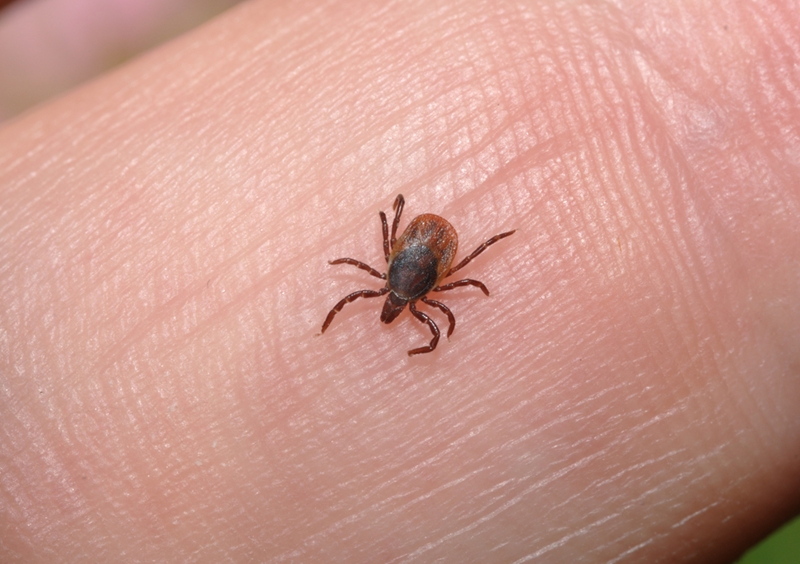The summer season means warmer weather, extra hours of sunlight, school vacations and therefore, more time spent outdoors. While the option to get outside more often is a perk of this time of year, it also carriers some hazards as well.
One of the biggest risks to be aware of when going out this summer is ticks. While these tiny arachnids may not seem menacing, they can transmit a number of serious diseases. Experts warn that the population numbers are rising, potentially putting more Canadians at risk this year.
Ticks Spread Lyme Disease
One of the most well-known tick-borne illnesses, Lyme disease can be a serious condition. It can only be spread to people or animals via bites from infected ticks, not from contact with any other infected being. The Government of Canada reports that two species of tick can spread this disease - the blacklegged or deer tick, found in the southeast and southcentral areas of the country, and the western blacklegged tick which takes up residency in British Columbia.
When ticks are able to find a host, whether it be a wild mouse, pet dog or a person, it finds a place to hide and bites down to feed. Unless they're found and removed, they can stay on one host for up to a week or more on average. They contract Lyme disease by eating the blood of an infected creature, then transmit this disease to the next thing they feed on.
 Two species of blacklegged tick can be found in Canada.
Two species of blacklegged tick can be found in Canada.
Symptoms of Lyme Disease
The effects of Lyme disease may start to show in as little as three days after infection, or could take up to a month. For people who are otherwise healthy, symptoms typically include:
- A rash, often making a bullseye pattern near the bite location.
- Fever.
- Headache.
- Fatigue.
- Chills.
- Achy joints and muscles.
- Swollen lymph nodes.
For most who contract Lyme disease, symptoms can clear up in a few weeks with timely treatment, though side effects such as interrupted sleep, headaches and lingering joint and muscles aches can last for a few months or years later.
Vulnerable populations, however, are at risk for escalated symptoms. Young children, the elderly and people with immune system illnesses are most likely to develop these complications. However, anyone could potentially experience severe Lyme symptoms, especially if treatment was delayed. These effects include:
- More frequent, severe headaches.
- Facial paralysis.
- Heart palpitations.
- Dizziness.
- Confusion.
- Nerve pain.
- Extremity numbness.
- Arthritis.
- Death.
Lyme disease can be treated with antibiotics. The sooner the medication is started, the better the chances are for a quick recovery. If you've been bitten by a tick, or experience Lyme-like symptoms and may have been bitten by a tick, seek medical attention immediately.
 Lyme disease can cause flu-like symptoms, such as fever, chills and aches.
Lyme disease can cause flu-like symptoms, such as fever, chills and aches.
Preventing Lyme Disease
Since Lyme disease can only be transmitted by tick bites, the best way to avoid the illness is to prevent being bitten. These pests primarily live in grassy or wooded areas. Use bug spray and dress in light, long sleeves and pants before venturing into tall fields or forests, CBC News suggests. Activities like hunting, golfing or hiking can make people especially vulnerable.
Because they're so small, ticks may be able to avoid detection, even when they bite. When you go back inside after an outdoor adventure, look for any ticks on your person. Be especially diligent about checking your clothes and hair, as ticks will try to hide.
If you do find a tick, don't try to squash it. Use pieces of tape to trap it, then flush it instead. If the tick has bitten you, carefully remove it with clean tweezers and don't yank or twist as you pull it away - this could cause part of the tick to remain in your skin. When possible, save ticks that have bitten and take them with you to the doctor to have them tested for Lyme.
To help keep ticks out of your home, search your pets and any outdoor equipment before bringing them inside. Lyme disease can be dangerous for dogs and cats as well, so talk to your vet about Lyme vaccines or tick treatments for your pets.
The Rise of Lyme Disease in Canada
Just a few years ago, there were relatively few cases of Lyme disease. The Government of Canada reported 144 known cases in 2009. That number has been climbing dramatically ever since, however. In 2016 there were 987 cases reported. Experts warn that this year's number could climb even higher.
Global News stated that warmer weather patterns and deciduous forests in Canada have made parts of the country more welcoming to ticks. The source added that up to 20 per cent of ticks tested positive for Lyme disease in Canada in 2016.
Lyme disease can be dangerous, or at the very least, highly uncomfortable. But by taking the right precautions and remaining vigilant when you go outside, you can stay safe from Lyme this summer.